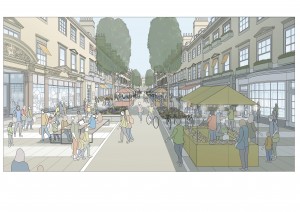Plans to develop a world-class creative quarter in central Bath should be extended into a more ambitious masterplan for the whole city, including improving its transport, commercial viability and sustainability.
The argument, put forward by Bath Preservation Trust – the charity set up in 1934 to safeguard the city’s unique historic setting – follows publication of Bath & North East Somerset Council’s Milsom Street Masterplan.

The council has described its draft blueprint as a vision for the next 20 years.
Under the scheme, Bath’s world-renowned Fashion Museum would be relocated from the Assembly Rooms, its home for almost 60 years, to a currently unused 22,000 sq ft building at the heart of the Milsom Quarter.
This would act as a catalyst for the transformation of the area, which stretches from George Street in the north to Upper Borough Walls in the south, and west from Queen Square to the Cattlemarket car park in the east, attracting high-end retailers and workspaces for creative businesses.
While Bath Preservation Trust welcomed the Milsom Street Masterplan, it is calling on the council to be more ambitious and come up with a long-term strategy for the whole city.
Trust CEO Alex Sherman said: “We think the plan in isolation is good but has the potential to be excellent.
“Developing a vision for one part of the city highlights the more pressing requirement for a strategy for the whole of Bath so that this masterplan, and others, are not considered in isolation.

“We need much more integration with a vision for the future of Bath as a whole – this masterplan should sit alongside a comprehensive overarching strategy or strategic plan for the development of the city, which includes city-wide public realm, transport and movement, commercial vision and sustainability.
“That vision does not currently exist, and it really needs to.”
The Trust “strongly encourages” that the current masterplan should be accompanied by “a robust and compliant streetscape maintenance strategy that sets out the approach and timetables for essential and overdue repairs to hard landscaping and guideline complaint materials,” added Mr Sherman.
This must be implemented and enforced by the council, with a consistent city-wide approach.
The Trust also said the Milsom Quarter plan had a “disproportionate emphasis” on a fashion-led renewal.
The council believes the rehoused Fashion Museum will act as a magnet for fashion retailers to move into the area.
But the Trust, pointing to the high number of empty shops in Bath city centre, said it feared the retail industry was fragile with there was little evidence that consumers were returning to the high street in the numbers necessary to facilitate significant growth.
Mr Sherman added: “The ‘build it and they will come’ approach needs a solid understanding of the market and the potential for private investment, which is not there right now.
“Also, Milsom Street represents the communal heart of Bath in the present day for major events and civic functions, and more should be made of this in the vision for the area.”
The Trust is also concerned that the character of historic Walcot Street, which has become Bath’s main area for artisan craft shops and eateries, is not protected in the council’s long-term vision for the city centre.
As the gateway to Walcot Street, The Cattlemarket site deserved development that responded to the character of Walcot and protected views to Bathampton Down, it argues.
The visualisations in the masterplan failed to illustrate a locally distinctive or heritage-sensitive response and did not show a form of development “harmonious with Walcot Street” it added.
The council was also missing a huge opportunity to lead on sustainability, the Trust said.
“Given that a high percentage of property within the masterplan area is owned by the council, this is a significant opportunity for it to lead by example to facilitate and undertake sustainability retrofits, switch from gas to electric, and introduce micro-renewables on an impressive scale,” it added.
“This longer-term, city-wide approach is required if Bath is to reach net zero by 2030. Targets won’t be met unless the council take direct climate action for its own buildings and land.
As well as encouraging and supporting the conservation of the city, Bath Preservation Trust also operates the museum in No.1 Royal Crescent, Beckford’s Tower, the Museum of Bath Architecture and the Herschel Museum of Astronomy,
It receives no statutory funding and is supported by visitor income, grants, legacies, donations and around 1,400 members who share a passion for the city and its environs.



















